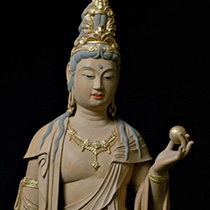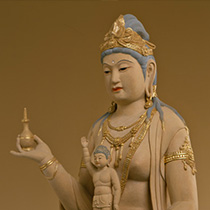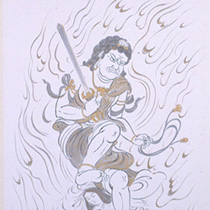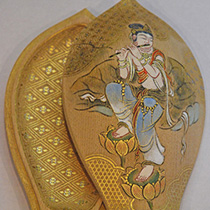History of Matsuhisa Sohrin
Member
-

Matsuhisa Hohrin
Great Buddhist Sculptor of Shiten’nō-ji
Great Buddhist Sculptor of Kuon-ji, Minobu-san
Great Buddhist Sculptor and Hokkyō of Enryaku-ji, Hiei-zan -

Matsuhisa Sohrin
Great Buddhist Sculptor of Shiten’nō-ji
Great Buddhist Sculptor of Shinshō-ji, Narita-san -

Matsuhisa Kayu
Director of Matsuhisa Buddha Statue Sculpture Hall
Director of Matsuhisa Sohrin Buddhist Studio
Director of Religion Art Academy -

Matsuhisa Maya
Representative of Shōsōin Kirigane

Matsuhisa Hohrin
(1901~1987)
Great Buddhist Sculptor of Shiten’nō-ji
Great Buddhist Sculptor of Kuon-ji, Minobu-san
Great Buddhist Sculptor and Hokkyō of Enryaku-ji, Hiei-zan
※Please click pictures for zoom
Carving Without a Word
Matsuhisa Hohrin was born in Meiji 4(1901) at Kyoto. He started to sculpture buddha statues at the age of 10, and keep making buddha statues for 70 years until he passed away in Showa 62(1987).
Among that period, it is said that he has made 5000 or 8000 works, however he just said “I don’t remember how many buddha statues I have made and it’s not important”.
Heart to Buddha Statues
The most important thing for Hohrin was “the heart to buddha statues”.
“When we see stone buddha statues at a roadside, and even though they are not good works, we cannot but worship with folded hands. It is because the sculptor made them with the heart of worship. And that heart of worship should be the root of the attitude for those who sculpture buddha.”
Hohrin consistently taught this “heart” to his pupils and members of the religion art academy.
One Person, One Buddha
Hohrin advocated the thought of “one person, one buddha”.
There’s buddha inside everyone’s heart. We chisel out that buddha by our hand and receive it as a shape. By receiving it, we can keep the shape of buddha in our heart. Hohrin taught how to make buddha statues with such wish of “one person, one buddha”.
Hohrin’s Mind
At workshop, Hohrin brings his chisel all the time except meal time. His sculpture style is free and easy just like his life. One pupil honoured that “Every details of buddha statues made by teacher Hohrin is living.”.
Hohrin said, “Just by skills, people don’t worship such buddha statues. It’s not the matter of skill but the wish to receive buddha in your heart, that’s the most important.” and many people visited the workshop everyday in order to admire such Hohrin.
There were offers of lecture from around Japan and he replied willingly. So in his late years he was so much busy, but he enjoyed it, saying “It’s a good and grateful thing.” Probably, for Hohrin, being busy like such felt to be the proof that the seeds of sculpture of buddha statues he and Sohrin sowed has bloomed and made the fruits.


Matsuhisa Sohrin
(1926~1992)
Great Buddhist Sculptor of Shiten’nō-ji
Great Buddhist Sculptor of Shinshō-ji, Narita-san
※Please click pictures for zoom
Loving Buddha Sculpture
For Sohrin Matsuhisa, sculpturing buddha statues is not job or work, but it’s daily life itself and kept carving just like buddha had appeared upon his body.
“Nobody loves buddha sculpture as much as I.” Sohrin was proud like that and he loved the world of buddha statues. Furthermore, he cared and trained those who had came into such world as fellows to enjoy making buddha. That’s because he wanted to spread the pleasure of buddha sculpture by teaching fairly not only to pupils who trains as professional buddhist sculptor but also to amateur devotees. It seemed that he felt it was his responsibility to tell his skills to others generously which is learnt from ancient
buddha statues.
Myojo-avalokiteśvara statue
Sohrin was proud of being called “kyo-busshi”, and as its reputation, he made many buddha images which are gorgeous and delicate. Among them he prefered to make avalokiteśvara.
Myojo-avalokiteśvara, one of his masterpiece made in Showa 48(1973), is the main deity of Matsuhisa Sohrin buddhist studio and is foundation of pupils.
He made an avalokiteṡvara statue only after 2 months he started to train as buddhist sculptor and it was sold for 5 yen. After that, avalokiteśvara was his foundation of his buddhist sculptor’s life and core element of his world of buddha statues.
Conversation With Skills
Sohrin made buddha statues whenever he want to make and keeps all buddha images, made in such way, around him. It seems that by doing so he let anybody to look at them any time and let them learn anything from that, if they can. Such his attitude remains unchanged until now and buddha images made by Sohrin having a conversation with those who want to make buddha statues, and become models for them.


Matsuhisa Kayu
Director of Matsuhisa Buddha Statue Sculpture Hall
Director of Matsuhisa Sohrin Buddhist Studio
Director of Religion Art Academy
※Please click pictures for zoom
Inherit Sohrin’s Chisel
She was born at Kyoto as second daughter of Matsuhisa Sohrin. After she learned Nihon-ga(Japanese style painting) at Hiyoshigaoka High School and Kyoto College of Art, she became buddhist painter at Institute of Buddha Sculpture Kyoto(Matsuhisa Sohrin Buddhist Studio at present), which Sohrin founded.
Looking at Buddha
Few years later, in order to express buddha from her inspiration more precisely, she learned the skill of suiboku-ga(ink wash painting) as a pupil of Kasei Ueda.
Kayu Matsuhisa mentioned in her writing, “Maybe traditional suiboku-ga and skills of nihon-ga, which I learned when I was student, mixed together inside me. I finally met up with the buddha, which I’ve been imagined in my heart but haven't appeared.”.
Unlike buddha images which are made only for enshrining in temples, she is making many pieces of buddhist painting from her free inspiration for just enjoying.
In Heisei 4, after Sohrin passed away, she became representative of Matsuhisa Sohrin Buddhist Studio and Religion Art Academy. And she started to sculpt buddha statues, using Sohrin’s chisel.
Free Inspiration
At first, with the help from the seniors at Matsuhisa Sohrin Buddhist Studio, she made one buddha statues every year. However these years, she is making buddha statues by using her own style, which is trained from buddhist painting.


Matsuhisa Maya
Representative of Shōsōin Kirigane
※Please click pictures for zoom
Encountering kirigane
She was born at Kyoto as Matsuhisa Sohrin’s eldest daughter. After she graduated from high school, she tried to become designer and learned designs around various field(mainly commercial designs) at Institute of International Design.
After that, as his father Sohrin insisted, she began to learn kirigane. At that time, kirigane was only men’s industry, but she learned from a kirigane craftsman who worked with Sohrin and acquired basic skills. And she become the first kirigane craftswoman.
However while she was learning, she thought that why kirigane skill wasn’t taught openly and worried about its future.
Kirigane to Everyone
In Showa 54, she wrote “The skills of kirigane” and this was the first time to introduce the skills to everyone. At the same time, she opened kirigane classes at Religious Art Academy to teach kirigane skills to every people.
From that classes, many pupils learned and graduated. Some of them become professional kirigane craftsman and others use the skills for enjoying as amateur devotee.
“I have to teach everything what I know about kirigane.” this is the attitude of teaching of Maya Matsuhisa and many people are going to her kirigane class now.
Creating and Teaching
With the thought that “kirigane is essentially used for buddha statues and buddha paintings.”, she tried the potential of kirigane to various kinds of objects, and at present, she, as a pioneer of kirigane craftswoman, walking the path of “Creating and Teaching” in her own way.
















